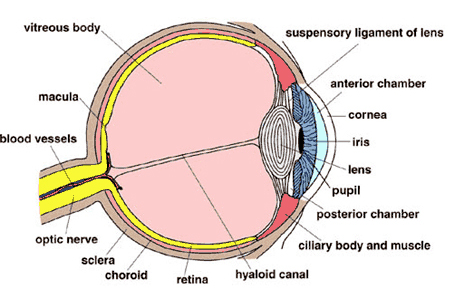FAQ | Overview

The retina is a delicate film containing rod and cone photoreceptor cells. It has the thickness of clear plastic wrap and the tensile strength of wet tissue paper. Vision originates in the retina. The photoreceptor cells convert light into electrical impulses and transport these impulses to the brain via the optic nerve for further processing. Diseases and anomalies of the retina may affect retinal function alone, or in some instances, the retina and its function are altered by disease that originates elsewhere. These conditions can cause the cells of the retina to malfunction or deteriorate over time, leading to a visual impairment. There are many types of retinal disorders and different kinds of visual deficits are encountered by patients with retinal disorders.
What is a retinal disorder?
A retinal disorder occurs when the retina malfunctions. In normal vision, the retina acts like the film in a camera. It is here where the pictures are created, so to speak, and then transmitted to the brain for interpretation.
Most disorders of the retina involve a disruption in the transmission of information from the photoreceptors to the brain. There are two types of photoreceptor cells: rods and cones. Rod cells function best in dim light and thus help us see in dimly lit environments. Cone cells function best in light and thus help us to see in daylight. Specifically, they are used for fine, detailed vision and allow us to perceive color. The cones are concentrated in the fovea, which is located at the center of the retina. Peripheral to the fovea, there is a higher concentration of rod cells and the cones are more widely spaced and interspersed within the rods.
What causes a retinal disorder?
There are numerous disorders of the retina, each with their unique features that may lead to different kinds of visual deficits. Though many retinal disorders are inherited, some are caused by the adverse effects of medications or by infections.
Retinopathy of prematurity (ROP) is a condition that occurs in premature infants, which results in problems with blood vessels that grow out of control along the retina. Some retinal disorders are related to illness, such as diabetes, while others can be caused by medications, such as seizure medications or chemotherapy, which can have a toxic effect on the retina.
Most retinal conditions fall into two broad categories: stationary and progressive. Even within these two groups there is a diverse mix of symptoms and severity of visual impairment. While stationary retinal diseases are present at birth, the level of vision loss remains the same over time. Examples of stationary conditions include Leber congenital amaurosis, which causes severe visual impairment, and congenital stationary night blindness, which results in decreased night vision. Progressive conditions may not be apparent at birth, but as time passes vision decreases. An example of this is retinitis pigmentosa, which results in a wide range of decreased vision.
What are the symptoms of a retinal disorder?
The symptoms of a retinal disorder vary widely from patient to patient, depending on the type of disorder, whether it is degenerative, where in the retina it originates, and whether it affects the rod or cone cells, or both. Generally speaking, children and adults with a retinal disorder may experience any of the following symptoms:
- poor vision at night (night blindness) and trouble adjusting from brightly lit areas to dim ones
- sudden or unexplained loss of vision
- loss of peripheral vision
- loss of vision in a particular visual field
- nystagmus, a rapid, involuntary oscillatory motion of the eyeball
- photophobia, an abnormal sensitivity to or intolerance of light
Can retinal disorders be treated?
For most retinal degenerations (retinal conditions where vision loss is progressive) there is no cure. However, patients can benefit greatly from receiving an accurate diagnosis, with detailed prognosis, provision of low-vision aids, and genetic counseling. In some conditions, such as retinopathy of prematurity or macular degeneration, laser surgery can be used to destroy abnormal blood vessels and prevent further loss of vision.
